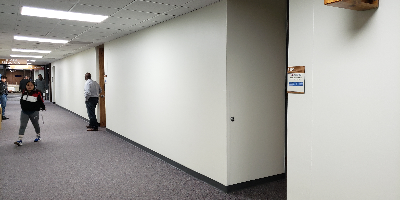jul 6, 1863 - Union Pacific Railway Co. Eastern Division
Description:
(Photo: Locomotive No. 17 formerly the Choctaw switching cars at Wyandotte City, Kansas during the 1860's Union Pacific Railway Eastern Division)On July 6,1863 the LP&W RW was acquired by John Fremont and Samuel Hallett and renamed the Union Pacific Railway Co. Eastern Division (UPRW-ED). The cost for the acquisition was $200,000 in cash and responsibility for all the previous LP&W RW promissory liabilities on land and stock. The new UPRW-ED was not owned by the Union Pacific Railroad and was set up as a contender for the transcontinental route. Sam Hallett promoted his view that depending on who arrived first at Fort Kearney in the Nebraska Territory (the 100th meridian) would determine who would have control over building West to San Francisco (Coppin, p. 11). Hallett was a very energetic man who created a competition in what he deemed the race from New York City to San Francisco. The starting line was Omaha for the Union Pacific and Wyandott for the Union Pacific Railway Eastern Division. The success of Wyandott City was totally contingent upon the UPRW ED and the speed in construction of the Pacific Railroad from St. Louis to Kansas City, Missouri as well as construction of a bridge across the Missouri River into Kansas City, Missouri. In terms of railroads and most all economic interests Wyandotte County would be tied to its sister city across the Kaw.
John Fremont was elected the first president of the UPRW-ED and Samuel Hallett became General Superintendent. Fremont was an explorer in the West and the first Republican Party candidate for President in 1856. His father-in-law was Thomas Hart Benton, a Senator from Missouri who advocated for railroads. It was nearly impossible to find workers during the Civil War so Fremont hired a Canadian company to do the grading and lay rail. Samuel Hallett (1827-1864) was a New York investment banker with connections to railroad financiers in America and Europe. Part of this agreement was to complete the line from Leavenworth to Lawrence in two years or the company would go back to Thomas Ewing Jr. and his three associates (Collins, p. 9).
The Wyandotte Commercial Gazette reported on June 27, 1863 that grading was to commence shortly and that Fremont was selling his estate in California to devote himself fully to railroad business (Petrowski, p. 71). But construction was again so slow that Hallett drove the Canadian company from the property and sued for breach of contract. It is not known how Hallett was able to obtain a company of U.S. Troops to run the Canadian construction crew into the Kaw River before they surrendered (Coppin, p. 13). The Canadian firm tried to regain the work camp by legal mans of but failed after long litigation. Hallett’s boundless legal energy also worked on Fremont. Although Fremont owned controlling stock and was President of the Railroad, he succumbed to the pressures of Hallett as well as a new railway commission and sold out for his initial $250,000 investment to be reimbursed at a later date.
Hallett hired 200 laborers for his own railway construction company to finally begin grading a line from Leavenworth to Lawrence during the Civil War! Most of the laborers were Canadian immigrants who agreed to work for $1.50 and an agreement they would not have to serve in the military (Coppin p. 13). But Leavenworth officials were slow and waited too long in reaching a conclusion to purchase $100,000 in UPRW-ED stock that Hallett requested in August 1863 (Collins, 12). When Hallett heard that the Pacific Railroad had reached Jefferson City via St. Louis, he stopped work at Leavenworth and immediately moved to break ground at the mouth of the Kaw River to make a new terminus at Wyandott. Although Wyandott was small in population, the people were amenable to Hallett’s financial terms. Hallett acquired 50 miles of grading equipment and ran an advertisement in the Wyandotte Gazette on September 4, 1863 saying:
Samuel Hallett and Company
1000 laborers wanted to commence work on the UPRW-ED at Wyandott
Monday, 7th of September
$1.50 day cash paid on Saturday night
Foreman $50-$100 month
When the people of Leavenworth heard about all this publicity they were not happy. Their jealousy was aroused to the point where it was reported they now regarded Wyandott City as “the self-styled Queen of the West” (Coppin p. 14).
Added to timeline:
Date:
jul 6, 1863
Now
~ 162 years ago
